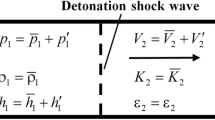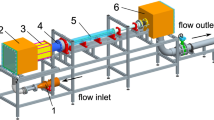Abstract
A study is made of the problem of a two-dimensional turbulent boundary layer on the moving surface of a cylindrical body (a Rankine oval with a relative elongation of four) moving at constant velocity in an incompressible fluid. For the numerical simulation of the turbulent flow of the fluid, the boundary layer is divided into exterior and interior regions in accordance with a two-layer model, using different expressions for the coefficients of turbulent transfer for each region. A study was nade of the development of the boundary layer on the body at different speeds of the body surface and different Reynolds numbers. The following integral characteristics were found by numerical calculation: the work of friction as the body is displaced; the work expended on the movement of its surface; and, for a flow regime with separation, the work of the pressure force. In this case the following model of separation flow is assumed: beyond the singular point in the solution of the boundary layer equations that indicates the appearance of a region of reverse flow, the pressure and friction stress on the wall are constant and are determined by their values at the singular point.
Similar content being viewed by others
Literature cited
B. C. Sakiadis, “Boundary-layer behavior on continuous solid surfaces. III. The boundary layer on a continuous cylindrical surface,” AIChE J.,7, 467 (1961).
F. K. Tsou, E. M. Sparrow, and R. J. Goldstein, “Flow and heat transfer in the boundary layer on a continuous moving surface,” Int. J. Heat Mass Transfer,10, 219 (1967).
A. T. Roper and G. L. Gentry (Jr), “Analysis of a turbulent boundary-layer over a moving ground plane,” NASA TN, No. D-6783, 72 (1972).
D. P. Riabouchinsky, “Étude expérimentale sur le frottement de l'air,” Bull. Inst. Aérodyn. Koutchino, No. 5, 51 (1914).
proc. Computation of Turbulent Boundary Layers-1963. AFOSR-IFP-Stanford Conf., Vol. 2, Stanford, Calif. (1969).
R. A. Antonyuk, “An experimental study of the velocity profile in the boundary layer on a partly moving surface,” Gidromekhanika. Resp. Mezhved. Sb., No. 32, 87 (1975).
A. S. Ginevskii, G. N. Emel'yanova, and A. V. Kolesnikov, “The turbulent boundary layer on a moving surface,” Uch. Zap. TsAGI,7, 40 (1976).
J. S. Tennant and T. Yang, “Turbulent boundary-layer flow fron stationary to moving surfaces,” AIAA J.,11, 1156 (1973).
J. S. Tennant, W. S. Johnson, and D. D. Keaton, “Boundary-layer flows from fixed to moving surfaces including gap effects,” J. Hydronaut.,12, 81 (1978).
G. G. Chernyi, “The boundary layer on a plate with a moving surface,” Dokl. Akad. Nauk SSSR,213, 802 (1973).
V. M. Zubarev, “The laminar boundary layer on the moving surface of a Rankine oval,” Izv. Akad. Nauk SSSR, Mekh. Zhidk. Gaza, No. 3, 175 (1984).
N. E. Kochin, I. A. Kibel', and N. V. Roze, Theoretical Hydrodynamics, New York (1964).
J. Williams III, “Separation of the boundary layer of an incompressible fluid,” in: Vortex Fluid Flow [Russian translation], Mir, Moscow (1979), pp. 58–100.
E. R. Van Driest, “On turbulent flow near a wall,” J. Aeronaut. Sci.,23, 1007, 1036 (1956).
T. Cebeci, A. M. O. Smith, and G. Mosinskis, “Calculation of compressible acliabatic turbulent boundary layers,” AIAA J.,8, 1974 (1970).
F. Clauser, “Turbulent boundary layers,” in: Problems of Mechanics, No. 2 [in Russian], Izd. Inostr. Lit., Moscow (1959), pp. 297–340.
V. G. Gromov and O. B. Larin, “A numerical analysis of the combustion of hydrogen in a supersonic boundary layer,” in: Nonequilibrium Gas Flows and Optimum Body Shapes in a Supersonic Flow [in Russian], Izd. MGU, Moscow (1978), pp. 74–94.
Author information
Authors and Affiliations
Additional information
Translated from Izvestiya Akademii Nauk SSSH, Mekhanika Zhidkosti i Gaza, No. 5, pp. 61–67, September–October, 1984.
Finally, the author would like to thank G. G. Chernyi and Yu. D. Shevelev for useful discussions and for their interest in this work.
Rights and permissions
About this article
Cite this article
Zubarev, V.M. The turbulent boundary layer on the moving surface of a cylindrical body. Fluid Dyn 19, 723–729 (1984). https://doi.org/10.1007/BF01093538
Received:
Issue Date:
DOI: https://doi.org/10.1007/BF01093538




